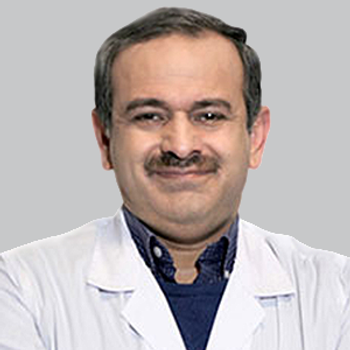
Recommendations for Assessment, Monitoring and Maintenance of Cognitive Health in MS
Dr Bruce Hughes and Dr Robert Naismith recommend assessments to aid physicians in evaluating and maintaining the cognitive health of patients with multiple sclerosis.
Episodes in this series

Bruce Hughes, MD: With regard to cognitive assessments, we obviously have formal neurocognitive testing batteries, and I think those are most optimal in assessing cognitive dysfunction but aren’t necessarily the most practical. Short of that, [for the] monitoring of patients for providers who don’t have easy access to repetitive neurological or psychological testing, what measures do you think clinicians can use that might give them some clues, aside from listening to the patient and family members, which I think is exceedingly important? Are there any other measures that may be useful for clinicians in practice?
Robert Naismith, MD: The National MS [multiple sclerosis] Society put together some recommendations several years ago. They got expert groups gathered to talk about the issues around cognition, and they recommend screening for cognition on a regular basis at baseline and, perhaps, annually. And the screening tests that they’re recommending is a processing speed test called the symbol digit modalities test [SDMT]. This could be done on paper and pencil, and there are now devices that you can do it [on, so it’s] computerized in clinic or even at home. We use a device in clinic to do the SDMT, on a [tablet]. It takes a couple minutes if you’re going to do it by paper. Already our visits are quite filled with assessments, so it’s always challenging to do more and more and more stuff. But I think getting some sort of assessment of processing speed is quite reasonable. And then also relying on your professional colleagues who specialize in cognition, because when they do a battery of cognitive testing, they’re going to do it in a very controlled manner with the proper instructions and the proper setting. It’s going to take several hours, but that’s their training. So you need to rely on other people to be able to help you do all those cognitive assessments and send them for those visits early on, and if they’re having any issues and we can talk more about in which scenarios might you be prompted to do that.
Bruce Hughes, MD: I like what you say, where you have busy practices, [and] fully assessing cognition can appear to be daunting. I think that symbol digit modality test…is one of the biggest bangs for your buck, because, like you said, it takes 90 seconds, 2 minutes to do. Unlike the PASAT [paced auditory serial addition test], it isn’t maddening to patients to do it. It does correlate pretty well with a brain volume loss. And that kind of segues into our next topic of therapies, our disease-modifying therapies, and there’s a whole bevy of data out there about their impact on total brain volume loss and brain matter structures present. Anything when you look at the different various disease-modifying agents that have positive impacts on reducing brain volume loss that come to mind?
Robert Naismith, MD: As we discussed, this is the process that begins early. It’s very challenging to detect because of this neurologic reserve and the compensation that patients undergo so that they have a normal exam, even though you know that they have atrophy taking place in various parts of the brain, so it’s challenging to detect it in an early stage. But I’ve been impressed with how well patients do when they are put on a higher-efficacy therapy earlier in the disease, because getting back to when we were discussing the acute inflammation, the chronic inflammation in the neurodegeneration, really, all of our therapies work on that acute inflammation component. So it’s really preventive care in terms of matching them up with the medicine that is going to serve them best. Because the other idea in MS care is you don’t want to overtreat. You don’t want to incur additional risks for patients who you feel are going to do fairly well based upon all the ways that we kind of prognosticate for patients, but certainly for patients who are demonstrating ongoing activity or ongoing symptoms or worsening other functions. These are the patients that you’re going to prioritize in terms of escalating their treatment to prevent that chronic inflammation, to prevent that neurodegeneration, to prevent that atrophy of the gray matter structures and the cortical thinning in the spinal cord. So [it is] really, to me, [about] treating MS the best way…that we can…. Unfortunately, that’s treating the inflammation. That’s where our therapies lie. We need therapies that are going to work on the neurodegeneration, on the repair aspect of it. We have a lot of trials going on. A lot of people are interested in developing these things, but we need to hit the MS inflammation at an early stage when the inflammation is at its greatest. And patients are also at their healthiest and doing the best because then they’re going to tolerate these therapies better than if you save them until later when they’re older. They have more comorbidities, and they’re not getting around as well. So, it’s that early intervention and early recognition, not necessarily treating everybody the same way, but trying to make that judgment in terms of this person seems like they’re having more issues; it’s time to move them up to the next therapy.
Bruce Hughes, MD: I completely agree. I think that we’ve always had that mentality and medicine of you start with something modest and potentially less expensive, and then if they respond well, fine. If not, then you escalate the therapies. And now I think we’re learning maybe 2 things with that is that clearly the high-efficacy therapies have better impact on outcomes, including brain volume loss. We’ve discussed, if you look at the bevy of articles presenting on brain volume loss impact, it’s the high-efficacy therapies that hands down do the best. And I also think just tincture of time, the fact that the high-efficacy therapies are newer than the lower efficacy therapies. So it took us a while to get comfortable with the safety profile of the high-efficacy therapies. And I think now we’re very comfortable with managing. So we have maximum efficacy, tolerability, and a good safety profile. To your point about when they’re best tolerated, we know that agents that impact the immune system may [create] issues when somebody is in the older age population, that…[they] may not be safe for them. So I think it continuously evolves, but I think starting…on high-efficacy therapies from the get-go is going to be best for your patients.
Robert Naismith, MD: Luckily, although they have things you need to be aware of and monitor for, they have relative ease of use for the efficacy that you get. Back when we started in this field, people talked about chemotherapy. And that was a very toxic type of treatment that required a lot of monitoring and had a lot of problems and [adverse] effects and issues for patients. These things were generally reserved for patients who were kind of in the progressive stages. So they were already past that point of inflammation, and they were probably getting a lot of risk with those types of therapies, the chemotherapies, and they were probably not getting a lot of benefit because it was too late. Whereas when you’re talking about our current high-efficacy therapies like S1P modulators and anti-CD20s, you do need to be careful in using these, but to me, it’s much easier than using chemotherapies or other things that we’ve had in the past. Certainly, you want to do all the lab work you need [upfront]…all the things to look out for. We’re always very concerned about opportunistic infections. We don’t want anything to happen to our patients, but we also know that MS is a bad disease for most patients. And that you have this window of opportunity to treat it with an anti-inflammatory therapy, and you want to do your best to get that right. Not to overtreat it, but not to undertreat it when you have that window. And if you’re outside that window, you know that the therapies, although you’re still going to use them, are not going to be as efficacious as if you used them earlier in the disease course.
Bruce Hughes, MD: Building on that, when you don’t want to overtreat, any tips for clinicians on identifying patients that are at higher risk for PIRA [progression independent of relapse activity] compared to others?
Robert Naismith, MD: I think the imaging is giving you tremendous clues to the future, because the imaging is giving you biomarkers of inflammation and degeneration. So we’re very concerned about the numbers of lesions and the locations of lesions. We know that patients who have 10 or more T2 lesions, lesions in the posterior fossa, the brain stem and the cerebellum, lesions in the spinal cord, these have all been shown through long-term studies to be associated with higher risk of secondary progressive MS. So someone who presents with 3 T2 lesions in the brain and none in the spinal cord versus someone who has 20 T2 lesions in the brain and 3 in the spinal cord, over time those people have drastically different risks. So that imaging is going to be really key to picking your first agent and it’s my job as a clinician to tell the patients why [I’m] steering in this direction. It’s not just, “We have all these things, what would you like to do?” But [it’s] “This is what your disease is telling me, and this is my recommendation based upon my experience and what I’m seeing on the imaging.” And then after that, with the visits, as we discussed earlier, monitor the patient to find out, “Do you feel like you’re stable, better or worse?” If [they’re] worse, tell me about the ambulation, the balance, the cognition, the upper extremity function, what’s going on at home, what’s going on with the family, what’s going on at work. All the things in terms of the pointed questions to kind of get into, is this working maximally for the patient? And if they continue to have issues despite this, then the question becomes, [is it] time to escalate because their disease seems to have ongoing issues that aren’t adequately controlled, and you want to maximize that treatment?
Transcript is AI-generated and edited for clarity and readability.
Newsletter
Keep your finger on the pulse of neurology—subscribe to NeurologyLive for expert interviews, new data, and breakthrough treatment updates.





































